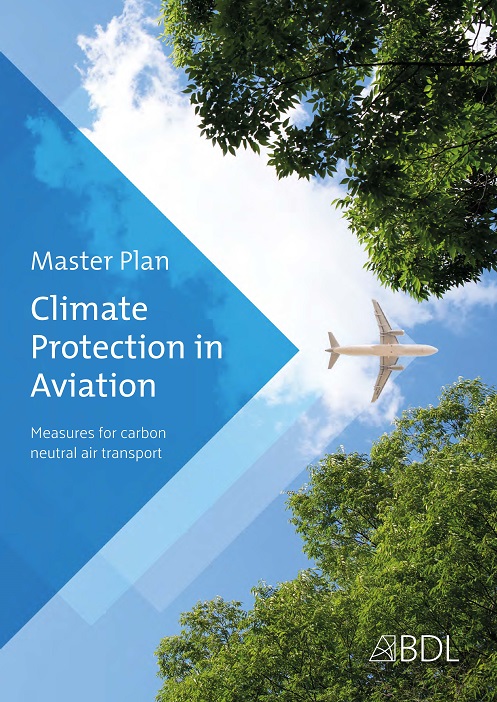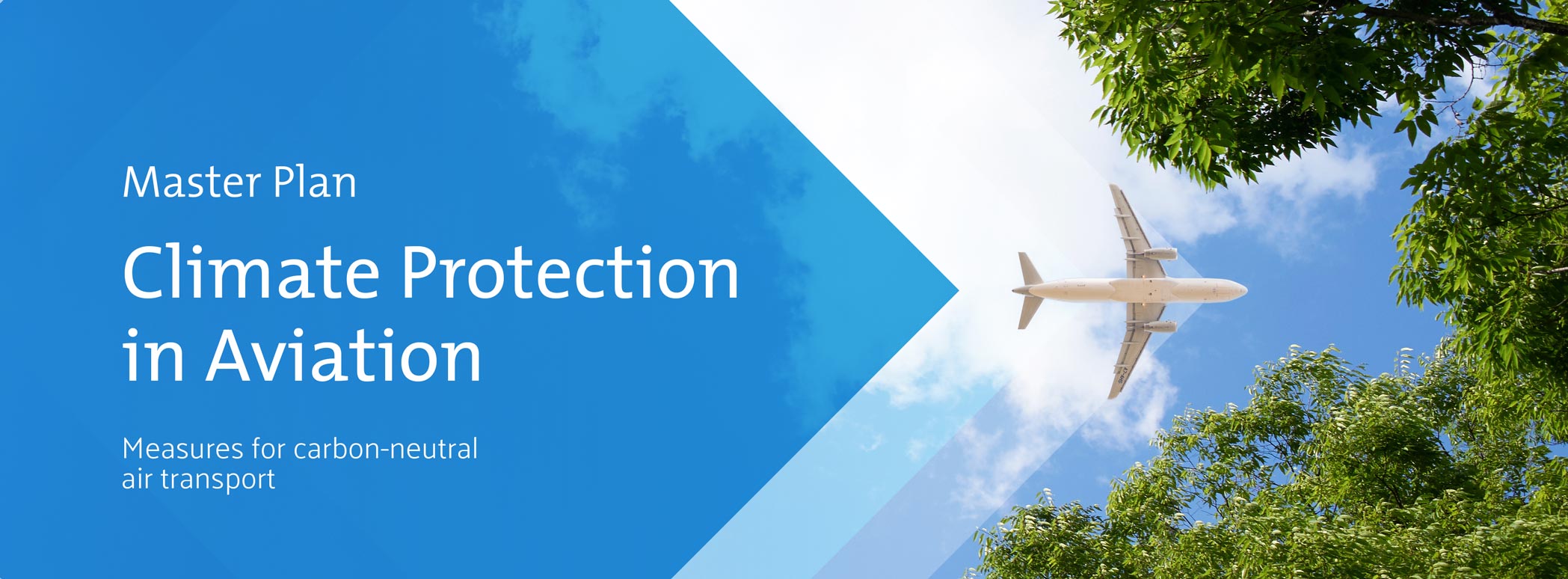
Master Plan: Climate Protection in Aviation
Our goal of carbon neutral aviation can be achieved if the specific measures outlined in this plan are pursued jointly by industry and governments.
Download | 1.1 MB

Our goal of carbon neutral aviation can be achieved if the specific measures outlined in this plan are pursued jointly by industry and governments.
Download | 1.1 MBIn the current Covid 19 crisis air traffic worldwide has come to a standstill, and along with it, of course, the associated emissions have been reduced. But the demand for air transport will increase again. Even if this will only happen gradually over a longer period of time, we are convinced: Climate protection continues to matter all of us and we must act sustainably and effectively.
In doing so, we also have to keep in mind the economic impact of the pandemic on the biggest levers for climate protection in aviation, because investments in climate protection require economically strong companies in the aviation branch.
We, the German aviation companies, are committed to the goal of carbon-neutral airport and flight operations.
Our goal of carbon-neutral air transport is attainable, if the concrete measures outlined below are promoted jointly by industry and politics:
Each new generation of aircraft requires up to 25 percent less kerosene and accordingly emits less CO2. With increasingly more energy-efficient aircraft and operating procedures, we have been able to reduce carbon emissions per passenger kilometre by 44 percent since 1990, and we want to continue investing in an ecological fleet replacement. In the long run, new aircraft engines will also help to reduce CO2 emissions of each flight.
With the collapse of air traffic due to the Corona pandemic, fleet renewal has largely come to a standstill. However, we want to continue renewing our aircraft fleets and equip them with more energy-efficient and lower-emission aircraft. In order to be able to achieve this, we would like to use the funds from the fleet renewal support programme which the German Government is preparing.
In order to achieve the goal of carbon-neutral flying, it is essential to replace fossil kerosene with sustainable aviation fuels. In the long term the best solution, also in ecological terms, is the use of fuels made from atmospheric CO2 produced by means of renewable energy. Aiming to make progress in this area, we are working together with politicians and the manufacturing industry to make this happen. In doing so, it is important to support measures that are neutral in terms of competition for airlines competing internationally.
To reduce the CO2 emissions of our airports in cooperation with their partners, we will implement concrete climate protection measures in facility management and airport operations.
In the field of power supply:
In the field of building services:
In the field of airport-specific facilities:
In the field of vehicle fleet/mobility:
The retail and catering businesses at airports are also taking steps towards carbon-neutrality.
The further development of a “Single European Sky” may contribute to active climate protection: By optimising flight routings within the German airspace, we have already been able to reduce detours and thus fuel consumption. At the European level, the introduction of Free Route Airspace has saved more than 2.6 million tonnes of CO2 since 2014, which corresponds to approximately 0.5 per cent of the CO2 emissions caused by aviation.
According to the SESAR Joint Undertaking, implementation of the Single European Sky could save 250 to 500 kg of fuel or 0.8 to 1.6 tonnes of CO2 per flight:
On short distances air traffic demand can be transferred to rail by strengthening intermodality.
In the past, numerous of domestic German air traffic demand has already been shifted to rail, and as a result, the operation of individual domestic German flight routes was discontinued. A successful transfer has always taken place when there was an attractive alternative travel offer, the corresponding infrastructure was available and the travel time by rail was no longer than three hours.
As a result, despite the growth in air traffic internationally, there has been no increase in the number of passengers in domestic German air traffic for many years. Domestic air traffic today accounts for 0.3 percent of carbon emissions in Germany. Today domestic flights within Germany essentially take place on longer routes only, i.e. where travel time by rail does not allow travellers to keep an appointment on the same day. For short distances, air transport is used almost exclusively by passengers changing planes of international flights.
In order to motivate even more passengers to use rail transport, we want to strengthen cooperation between modes of transport and improve the quality of rail travel.
We support CO2 pricing instruments,
Air transport almost always is international. Therefore, going it alone at national level is the wrong way to go. In particular, climate policy regulations through national taxes, charges or bans are ecologically and economically counterproductive. Such measures do not reduce CO2 emissions, but merely shift them to other regions (carbon leakage), where these taxes are not levied, at the expense of the respective domestic industry. Air traffic is not reduced, but only shifted. We oppose proposals on kerosene taxation because any CO2 pricing not introduced on an internationally binding basis would have the negative consequences of distorting competition and causing carbon leakage. Regulations for aviation should be made at international level, than they will be effective in terms of climate policy. Where this is not possible internationally, distortions of competition and carbon leakage must be avoided by other means.
There is a need for action to make the instruments of CO2 pricing competition-neutral and to avoid carbon leakage at the same time.
In addition to its CO2 emissions, aviation is also responsible for other emissions caused by the combustion of kerosene at high altitudes. These emissions also affect the climate, as they may contribute to the formation of clouds and other greenhouse gases. According to the IPCC, the total climate impact of air transport, including CO2, accounts for 3 to 5 percent of global warming and depends on various factors: Type and quantity of emissions, weather conditions, time of day and place of emission, dwell time and the geographical spread of the emissions. While the climate impact of carbon dioxide has been scientifically studied in depth, there is still a need for further research, for example, to assess the impact of contrails, cirrus clouds and nitrogen oxides on our climate. There are, however, various approaches that we are working to implement in order to reduce these effects: